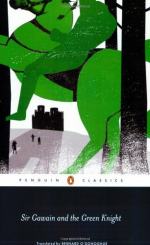|
|
Sir Gawain and the Green Knight Topic Tracking: Fear
Part 1, lines 1-249
Fear 1: Sir Gawain presents an interesting twist on the archetype of chivalrous knightly culture and the associated notions of gallantry. This is the first scene in the poem having to do with the Knights of the Round Table, a scene that establishes their credibility. They are portrayed not as dashing defenders of right, but as quaking children scared of supposed witchcraft. This is right after the poet has built them up as the pinnacle of their profession.
Part 1, lines 250-490
Fear 2: Here it seems that the Green Knight has called Arthur and his knights' bluff - they do not seem as courageous as their renown. However, the poet himself has built up Arthur and his followers as brave and fair knights, deserving of their fame - the greatest example of knights in the world. Even in the act of creating a legend, the poet mollifies the notion of creating a super-hero and a super-villain, and thus keeps the reader within the human sphere of experience even in the context of the fantastic. The poet's characters remain profoundly human even while they are fantastic and strange.
Fear 3: The knights seem almost desperately scared here - as the Green Knight's head comes off, they kick at it to get it away. This is a far cry from the idyllic image of dashing knights in shining armor unfazed by any danger. The knights are characterized as "afraid" when presented with the image of the headless Green Man sitting on his horse.
Part 2, lines 491-810
Fear 4: Here fear is put into a more traditionally acceptable framework - Gawain is not afraid for himself (except in a detached way in relation to religion), but instead fears that he will not get a chance to consummate his faith on Christmas. This is a virtuous portrayal, and a sign (from the poet), that faith is perhaps infallible, even as he portrays humanity and human ideals as weak and imperfect.
Part 3, lines 1558-1997
Fear 5: The hordes of hunters around the lord are characterized as too scared to fight the boar when it hides. This provides a startling contrast with the lord himself, who becomes the fearless savior of the day.
Fear 6: This is the first concrete instance where we see Gawain's humanity; to this point his has been built up repeatedly as the embodiment of perfection, a hero for the ages. But here Gawain's faults begin to show through, and the reader is called on to question the validity of the hero ideal. Perhaps the poet cannot be trusted as a wholly truthful narrator, or perhaps the poet built up the image just to tear it down in the end, twisting the hero myth with his irony. Nevertheless, Gawain becomes a complex and divided character, with his own inner demons to face, in how he should act both in the face of death and how the code of knightly conduct generally applies to himself.
Fear 7: This is Gawain's great blunder, and the display of weakness that proves the downfall of his ego. In accepting the green belt, Gawain shows that he fears for his life, a feeling directly at cross-purposes with the knightly "should." He becomes not a hero on his own terms, but a faulty man in need of external support.
Part 4, lines 1998-2308
Fear 8: Again, Sir Gawain's inner resolve and his sense of expectation of how he should act are put at odds when he tries to be brave in the face of the axe. The Green Knight, however, is the first person, perhaps in the poem, to speak the truth outright, when he calls Gawain's bluff of courage. All of the other intellectual-sparring that has covered up the truth to this point is cast aside for a moment, even if Gawain and the Green Knight do go on to spar in their own way. And even as the Green Knight tells the truth, he himself is not what he seems, and does not explain himself until later in the poem.
Part 4, lines 2309-2530
Fear 9: Here all of the truth is revealed, including the fact that the Green Knight, also the lord of the castle, could see through Gawain's actions all the time. And even though he upholds how Gawain acts, he reveals how transparent the values are. No one, not even the celebrated Gawain, can be perfect, and he has taught Gawain to recognize that in himself.




